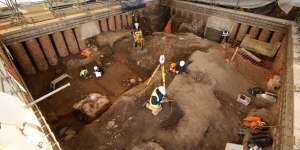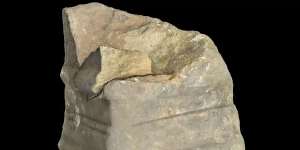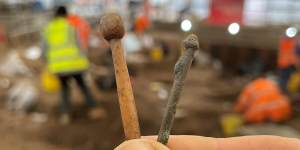Now,the source of the folklore may have been uncovered.

An archaeological dig in the grounds of Leicester Cathedral. Experts said they have uncovered what they believe to be a Roman shrine beneath a former graveyard in central England.University of Leicester Archaeological Services via AP
Archaeologists working at the cathedral have discovered evidence of a Roman shrine beneath the structure,which may have been used by worshippers of a fertility or mystery cult.
The small,painted chamber,measuring just four by four metres,contained an altar stone where sacrifices to Roman gods may have taken place.
The site may have been chosen because it was a sacred location for pagans,and that some form of worship had been happening there for 1800 years.

The Roman pagan altar discovered under the Leicester Cathedral.University of Leicester Archaeological Services via AP.
Mathew Morris,project officer at University of Leicester Archaeological Services,who led the excavations,said:“Given the combination of a subterranean structure with painted walls and the altar we have found,one interpretation... could be that this was a room linked with the worship of a god or gods.”
The archaeologists believe the room was a private place of worship of either a family,or a cult room where a small group would meet.
Similarly,underground chambers like this have often been linked with fertility and mystery cults,and the worship of gods such as Mithras,Cybele,Bacchus and Dionysus.
No evidence of an inscription survived on the altar,so it is unclear which gods were being honoured.
Excavations have been carried out ahead of the construction of a new heritage centre in the cathedral gardens.

Two Roman hairpins from the dig in Leicester. On the left,a pin with a spherical head carved from animal bone,and on the right a copper alloy pin with a grooved head (probably broken). University of Leicester Archaeological Services
In the final stages of the dig,when the team was three metres down,researchers uncovered evidence of a well-made semi-subterranean structure with painted stone walls and a concrete floor.
The sunken room was probably built in the second century,when Leicester was the Roman town Ratae Corieltavorum. It was deliberately dismantled and in-filled,probably in the late third or early fourth century.
Within that space,lying broken and face down amid the rubble,they also found the base of an altar stone,carved from local Dane Hills sandstone and measuring approximately 25 centimetres by 15 centimetres with decorative mouldings.

John Thomas,deputy director at ULAS,said:“Fortunately,the archaeology was very well-preserved and while there is still a lot of analysis work still to do,we are confident that we’ll be able to address all of our questions and more.”
Telegraph,London
Get a note directly from our foreigncorrespondentson what’s making headlines around the world..